
Chiricahua is a band of Apache Native Americans.

Gerónimo was a military leader and medicine man from the Bedonkohe band of the Ndendahe Apache people. From 1850 to 1886, Geronimo joined with members of three other Central Apache bands – the Tchihende, the Tsokanende and the Nednhi – to carry out numerous raids, as well as fight against Mexican and U.S. military campaigns in the northern Mexico states of Chihuahua and Sonora and in the southwestern American territories of New Mexico and Arizona.

The Apache Wars were a series of armed conflicts between the United States Army and various Apache tribal confederations fought in the southwest between 1849 and 1886, though minor hostilities continued until as late as 1924. After the Mexican–American War in 1846, the United States annexed conflicted territory from Mexico which was the home of both settlers and Apache tribes. Conflicts continued as American settlers came into traditional Apache lands to raise livestock and crops and to mine minerals.
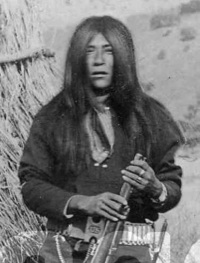
Massai was a member of the Mimbres/Mimbreños local group of the Chihenne band of the Chiricahua Apache. He was a warrior who was captured but escaped from a train that was sending the scouts and renegades to Florida to be held with Geronimo and Chihuahua.

The Navajo Scouts were part of the United States Army Indian Scouts between 1873 and 1895. Generally, the scouts were signed up at Fort Wingate for six month enlistments. In the period 1873 to 1885, there were usually ten to twenty-five scouts attached to units. United States Army records indicated that in the Geronimo Campaign of 1886, there were about 150 Navajo scouts, divided into three companies, who were part of the 5,000 man force General Nelson A. Miles put in the field. In 1891 they were enlisted for three years. The Navajos employed as scouts were merged into regular units of the army in 1895. At least one person served almost continuously for over twenty-five years.
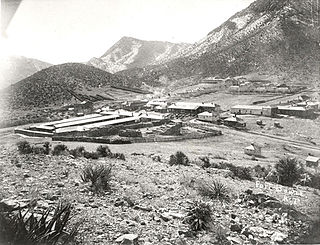
Fort Bowie was a 19th-century outpost of the United States Army located in southeastern Arizona near the present day town of Willcox, Arizona. The remaining buildings and site are now protected as Fort Bowie National Historic Site.

The Apache Scouts were part of the United States Army Indian Scouts. Most of their service was during the Apache Wars, between 1849 and 1886, though the last scout retired in 1947. The Apache scouts were the eyes and ears of the United States military and sometimes the cultural translators for the various Apache bands and the Americans. Apache scouts also served in the Navajo War, the Yavapai War, the Mexican Border War and they saw stateside duty during World War II. There has been a great deal written about Apache scouts, both as part of United States Army reports from the field and more colorful accounts written after the events by non-Apaches in newspapers and books. Men such as Al Sieber and Tom Horn were sometimes the commanding officers of small groups of Apache Scouts. As was the custom in the United States military, scouts were generally enlisted with Anglo nicknames or single names. Many Apache Scouts received citations for bravery.

Kas-tziden or Haškɛnadɨltla, more widely known by his Mexican-Spanish appellation Nana, was a warrior and chief of the Chihenne band of the Chiricahua Apache. A trusted lieutenant to Cuchillo Negro and Mangas Coloradas, in the 1850s and 1860s he was one of the best known leaders of the Chihenne (Tchiende), along with Tudeevia, Ponce and Loco. He was a nephew of Delgadito, and married a sister of Geronimo.
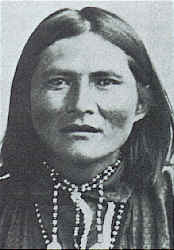
Alchesay, also known as William Alchesay, Alchisay and Alchise, was a chief of the White Mountain Apache tribe and an Indian Scout. He received the United States military's highest decoration for bravery, the Medal of Honor, for his actions during the Indian Wars.
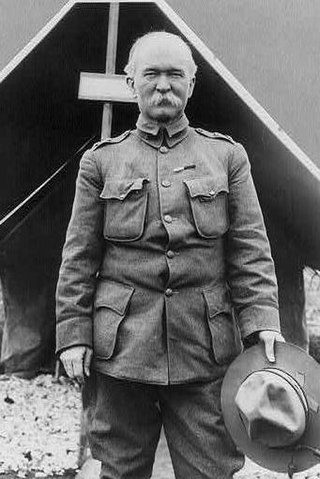
William Giles Harding Carter was a US Cavalry officer who served during the American Civil War, Spanish–American War and World War I. He also took part in the Indian Wars seeing extensive service against the Apache and Comanche in Arizona being awarded the Medal of Honor against the Apache during the Comanche Campaign on August 30, 1881.

Camillus "Buck" Sydney Fly was an Old West photographer who is regarded by some as an early photojournalist and who captured the only known images of Native Americans while they were still at war with the United States. He took many other pictures of life in the silver-mining boom town of Tombstone, Arizona, and the surrounding region. He recognized the value of his photographs to illustrate periodicals of the day and took his camera to the scenes of important events where he recorded them and resold pictures to editors nationwide.
The Fort Sill Apache Tribe of Oklahoma is the federally recognized Native American tribe of Chiricahua Warm Springs Apache in Oklahoma.

First Lieutenant Charles Bare Gatewood was an American soldier born in Woodstock, Virginia. He was raised in Harrisonburg, Virginia, where his father ran a press. He served in the United States Army in the 6th Cavalry after graduating from West Point. Upon assignment to the American Southwest, Gatewood led platoons of Apache and Navajo scouts against renegades during the Apache Wars. In 1886, he played a key role in ending the Geronimo Campaign by persuading Geronimo to surrender to the army. Beset with health problems due to exposure in the Southwest and Dakotas, Gatewood was critically injured in the Johnson County War and retired from the Army in 1895, dying a year later from stomach cancer. Before his retirement he was nominated for the Medal of Honor, but was denied the award. He was portrayed by Jason Patric in the 1993 film Geronimo: An American Legend.

Geronimo Campaign, between May 1885 and September 1886, was the last large-scale military operation of the Apache wars. It took more than 5,000 U.S. Army Cavalry soldiers, led by the two experienced Army generals, in order to subdue no more than 70 Chiricahua Apache who fled the San Carlos Apache Indian Reservation and raided parts of the surrounding Arizona Territory and adjacent Sonora state in Mexico for more than a year.
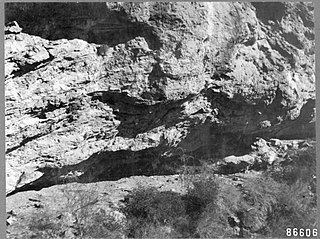
The Yavapai Wars, or the Tonto Wars, were a series of armed conflicts between the Yavapai and Tonto tribes against the United States in the Arizona Territory. The period began no later than 1861, with the arrival of American settlers on Yavapai and Tonto land. At the time, the Yavapai were considered a band of the Western Apache people due to their close relationship with tribes such as the Tonto and Pinal. The war culminated with the Yavapai's removal from the Camp Verde Reservation to San Carlos on February 27, 1875, an event now known as Exodus Day.

Chato was a Chiricahua Apache subchief who carried out several raids on settlers in Arizona in the 1870s. His Apache name was Bidayajislnl or Pedes-klinje. He was a protege of Cochise, and he surrendered with Cochise in 1872 going to live on the San Carlos Reservation in southern Arizona, where he became an Apache Scout. Following his service as a scout he was taken prisoner after being coerced to travel to Washington, D.C. Chato was imprisoned in St. Augustine, Florida along with almost 500 other Apache at Fort Marion.
First Lieutenant Britton Davis was an American soldier born in Brownsville, Texas. He served in the United States Army in the 6th Cavalry after graduating from West Point in 1881. After serving at Fort D.A. Russell, Davis was transferred to the Southwest to serve at San Carlos in 1882 during the Apache Wars where he commanded two companies of Apache Scouts alongside Captain Emmet Crawford. In 1886, he played a key role in ending the Geronimo Campaign.
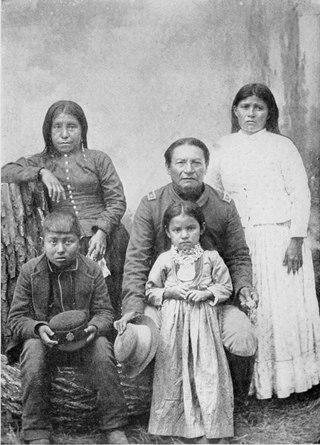
Chihuahua or Chewawa,, was chief of the Chokonen local group of the Tsokanende Band of Chiricahua Apache who carried out several raids on settlers in Arizona in the 1870s and 1880s. His elder brother Ulzana, who would later become known as leader of a very famous raid through New Mexico and Arizona in 1885, was his war chief (segundo). Chihuahua's name in the Mescalero-Chiricahua language was Kla-esh or Tłá'í'ez.
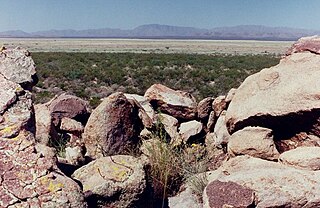
The Battle of Tres Castillos, October 14–15, 1880, in Chihuahua State, Mexico resulted in the death of the Chiricahua Apache chieftain Victorio and the death or capture of most of his followers. The battle ended Victorio's War, a 14-month long odyssey of fight and flight by the Apaches in southern New Mexico, western Texas, and Chihuahua. Mexican Colonel Joaquin Terrazas and 260 men surrounded the Apache and killed 62 men, including Victorio, and 16 women and children, and captured 68 women and children. Three Mexicans were killed. Victorio had little ammunition to resist the attack.
The Battle at Pozo Hediondo took place on January 20, 1851, during the Apache Wars. On January 20, 1851, a Mexican Patrol spotted a cloud of dust just south of Pozo Hediondo where it was believed the cloud of dust was created by a returning Indians from the North with the goods they had taken from a raid. The Mexican troops set up to ambush the Indian caravan. The Mexican forces outnumbered the Apache two to one and would attack them with bullets and arrows, forcing the Apache to abandon all the stock and goods they had just raided. Ignacio Pesqueria sent his Mexican troops to pursue the retreating Indians but failed to realize that Mangas Coloradas was coming up the valley to surprise attack the Mexican troops. The next three hours would consist of hand-to-hand combat, being referred to as "a war to the knife" by Coloradas.
















